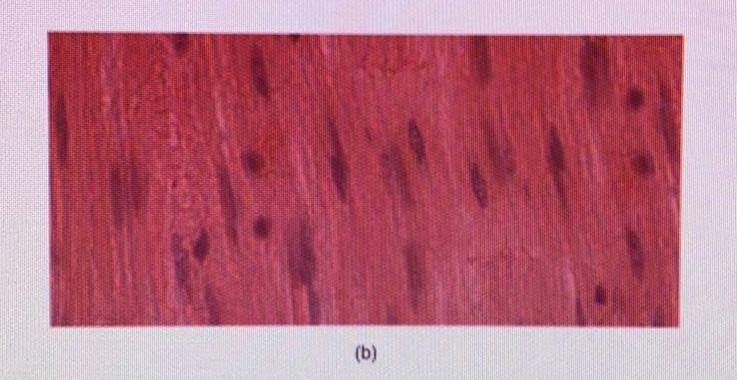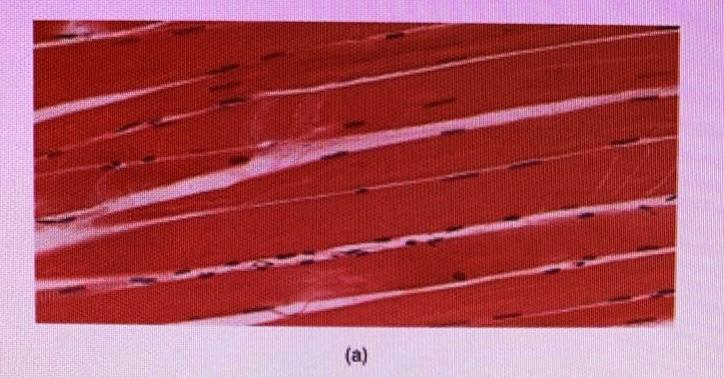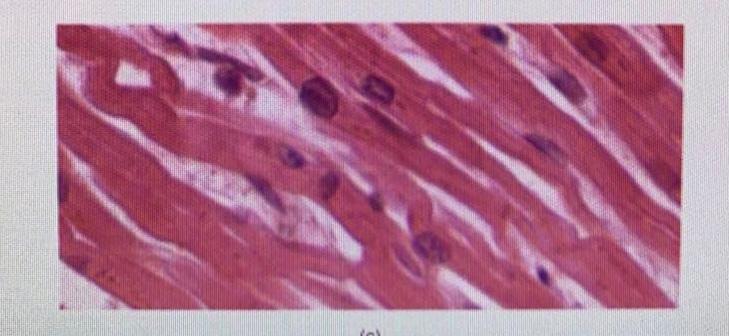Muscle that has a striped appearance is described as
being
________.
a. elastic
b. nonstriated
c.
excitable
d. striated
striated
Which element is important in directly
triggering
contraction?
a. sodium (Na+)
b. calcium
(Ca++)
c. potassium (K+)
d. chloride (Cl-)
calcium (Ca++)
Which of the following properties is not common to all three muscle
tissues?
a. excitability
b. the need for ATP
c. at
rest, uses shielding proteins to cover actin-binding sites
d. elasticity
at rest, uses shielding proteins to cover actin-binding sites
The correct order for the smallest to the largest unit of
organization in muscle tissue is ________.
a. fascicle, filament,
muscle fiber, myofibril
b. filament, myofibril, muscle fiber,
fascicle
c. muscle fiber, fascicle, filament, myofibril
d.
myofibril, muscle fiber, filament, fascicle
filament, myofibril, muscle fiber, fascicle
Depolarization of the sarcolemma means ________.
a. the inside
of the membrane has become less
negative as sodium ions
accumulate
b. the outside of the membrane has become
less
negative as sodium ions accumulate
c. the inside of the
membrane has become more
negative as sodium ions
accumulate
d. the sarcolemma has completely lost any electrical
charge
the inside of the membrane has become less
negative as sodium
ions accumulate
In relaxed muscle, the myosin-binding site on actin is
blocked
by ________.
a. titin
b. troponin
c. myoglobin
d. tropomyosin
tropomyosin
According to the sliding filament model, binding sites
on actin
open when ________.
a. creatine phosphate levels rise
b. ATP
levels rise
c. acetylcholine levels rise
d. calcium ion
levels rise
calcium ion levels rise
The cell membrane of a muscle fiber is called
________.
a.
myofibril
b. sarcolemma
c. sarcoplasm
d. myofilament
sarcolemma
Muscle relaxation occurs when ________.
a. calcium ions are
actively transported out of the
sarcoplasmic reticulum
b.
calcium ions diffuse out of the sarcoplasmic
reticulum
c.
calcium ions are actively transported into the
sarcoplasmic
reticulum
d. calcium ions diffuse into the sarcoplasmic
reticulum
calcium ions are actively transported into sarcoplasmic reticulum
During muscle contraction, the cross-bridge detaches
when
________.
a. the myosin head binds to an ADP molecule
b. the
myosin head binds to an ATP molecule
c. calcium ions bind to
troponin
d. calcium ions bind to actin
calcium ions bins to troponin
Thin and thick filaments are organized into functional
units
called ________.
a. myofibrils
b. myofilaments
c.
T-tubules
d. sarcomeres
sarcomeres
During which phase of a twitch in a muscle fiber is
tension the
greatest?
a. resting phase
b. repolarization phase
c.
contraction phase
d. relaxation phase
contraction phsase
Muscle fatigue is caused by ________.
a. buildup of ATP and
lactic acid levels
b. exhaustion of energy reserves and buildup
of
lactic acid levels
c. buildup of ATP and pyruvic acid
levels
d. exhaustion of energy reserves and buildup
of
pyruvic acid levels
exhaustion of energy reserves and buildup of lactic acid levels

smooth

Which type of muscle tissue is this?
skeletal

Which type of muscle tissue is this?
cardiac
A sprinter would experience muscle fatigue sooner than
a
marathon runner due to ________.
a. anaerobic metabolism in the
muscles of the
sprinter
b. anaerobic metabolism in the
muscles of the
marathon runner
c. aerobic metabolism in the
muscles of the sprinter
d. glycolysis in the muscles of the
marathon runner
anaerobic metabolism in the muscles of the sprinter
What aspect of creatine phosphate allows it to supply
energy to
muscles?
a. ATPase activity
b. phosphate bonds
c.
carbon bonds
d. hydrogen bonds
phosphate bonds
Drug X blocks ATP regeneration from ADP and
phosphate. How will
muscle cells respond to this drug?
a. by absorbing ATP from the
bloodstream
b. by using ADP as an energy source
c. by using
glycogen as an energy source
d. none of the above
none of the above
The muscles of a professional sprinter are most likely
to have
________.
a. 80 percent fast-twitch muscle fibers and
20
percent slow-twitch muscle fibers
b. 20 percent
fast-twitch muscle fibers and 80
percent slow-twitch muscle
fibers
c. 50 percent fast-twitch muscle fibers and
50
percent slow-twitch muscle fibers
d. 40 percent
fast-twitch muscle fibers and 60
percent slow-twitch muscle fibers
80 percent fast-twitch muscle fibers and 20 percent slow-twitch muscle fibers
The muscles of a professional marathon runner are
most likely to
have ________.
a. 80 percent fast-twitch muscle fibers and
20
percent slow-twitch muscle fibers
b. 20 percent
fast-twitch muscle fibers and 80
percent slow-twitch muscle
fibers
c. 50 percent fast-twitch muscle fibers and
50
percent slow-twitch muscle fibers
d. 40 percent
fast-twitch muscle fibers and 60
percent slow-twitch muscle fibers
20 percent fast-twitch muscle fibers and 80 percent slow-twitch muscle fibers
Which of the following statements is true?
a. Fast fibers have a
small diameter.
b. Fast fibers contain loosely packed
myofibrils.
c. Fast fibers have large glycogen reserves.
d.
Fast fibers have many mitochondria.
fast fibers have large glycogen reserves.
Which of the following statements is false?
a. Slow fibers have
a small network of capillaries.
b. Slow fibers contain the
pigment myoglobin.
c. Slow fibers contain a large number
of
mitochondria.
d. Slow fibers contract for extended periods
slow fibers have a small network of capillaries.
Cardiac muscles differ from skeletal muscles in that
they
________.
a. are striated
b. utilize aerobic
metabolism
c. contain myofibrils
d. contain intercalated discs
contain intercalated discs
If cardiac muscle cells were prevented from undergoing
aerobic
metabolism, they ultimately would ________.
a. undergo
glycolysis
b. synthesize ATP
c. stop contracting
d.
start contracting
stop contracting
Smooth muscles differ from skeletal and cardiac
muscles in that
they ________.
a. lack myofibrils
b. are under voluntary
control
c. lack myosin
d. lack actin
lack myofibrils
Which of the following statements describes smooth
muscle
cells?
a. They are resistant to fatigue.
b. They have a
rapid onset of contractions.
c. They cannot exhibit
tetanus.
d. They primarily use anaerobic metabolism
they are resistant to fatigue
From which embryonic cell type does muscle
tissue
develop?
a. ganglion cells
b. myotube
cells
c. myoblast cells
d. satellite cells
myoblast cells
Which cell type helps to repair injured muscle fibers?
a.
ganglion cells
b. myotube cells
c. myoblast cells
d.
satellite cells
satellite cells
Skeletal muscle is _________
attached to tendons/bones, striated, under voluntary control, multinucleated
Cardiac muscle __________
forms most of the wall of the heart, striated, involuntary control, one centrally located nucleus
Smooth muscle
non-striated, involuntary, one centrally located nucleus, found in walls of hollow internal structures
The four properties of muscle tissue include___________
excitability, contractility, extensibility, and elasticity
excitability
ability to respond to stimuli by producing electrical signals
contractility
ability to contract and generate force when stimulated
extensibility
ability to be stretched without damaging the tissue
elasticity
ability to return to original shape after contraction or extension
Each skeletal muscle is considered an ______
organ
deep fascia is composed of _____
dense irregular connective tissue around muscle with similar functions
epimysium_____
surrounds the whole muscle
perimysium______
surrounds bundles (fascicles) of 10-100 muscle cells
endomysium______
separates individual muscle fibers
aponeurosis _____
a sheet-like tendon joining one muscle with another or bone; formed when all connective tissue components come together
Each skeletal muscle is typically supplied by ______
a nerve, artery, and two veins
capillaries in skeletal muscle_____
bring oxygen and nutrients and remove heat and wastes
How do mature muscle cells develop?
from 100 myoblasts that fuse together in the fetus
What fills the sarcoplasm?
myofibrils, glycogen, and myoglobin (red-colored, oxygen-binding protein)
The filaments of myofibrils are arranged into ______
sarcomeres
Four steps of contraction cycle include:
1) ATP hydrolysis 2) attachment of myosin to actin to form crossbridges 3) power stroke 4) detachment of myosin from actin
Four steps of nerve impulse illiciting muscle action potential
1) release of ACh 2) activation of ACh receptors 3) production of muscle action potential 4) termination of ACh activity